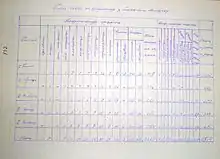Manastir Vilayet
The Vilayet of Manastir[3] (Ottoman Turkish: ولايت مناستر, romanized: Vilâyet-i Manastır)[4] was a first-level administrative division (vilayet) of the Ottoman Empire, created in 1874, dissolved in 1877 and re-established in 1879.[5] The vilayet was occupied during the First Balkan War in 1912 and divided between the Kingdom of Greece and the Kingdom of Serbia,[5] with some parts later becoming part of the newly established Principality of Albania.
| ولايت مناستر Vilâyet-i Manastır | |||||||||||||
|---|---|---|---|---|---|---|---|---|---|---|---|---|---|
| Vilayet of the Ottoman Empire | |||||||||||||
| 1874–1877 1879–1912 | |||||||||||||
.png.webp) The Manastir Vilayet in 1900 | |||||||||||||
| Capital | Manastir[1] | ||||||||||||
| Population | |||||||||||||
• 1911[2] | 1,069,789 | ||||||||||||
| History | |||||||||||||
• Established | 1874 | ||||||||||||
• Disestablished | 1912 | ||||||||||||
| |||||||||||||
| Today part of | |||||||||||||
Administrative divisions
.jpg.webp)

Initially the Manastir Vilayet had the following sanjaks:[6]
After administrative reforms in 1867 and 1877 some parts of the Manastir Vilayet were ceded to newly established Scutari Vilayet (1867) and Kosovo Vilayet (1877).
Administrative divisions of Manastir Vilayet until 1912:[7]
- Sanjak of Manastir: Kazas of Manastir (Bitola), Pirlepe (Prilep), Florina, Kıraçova (Kičevo) and Ohrid.
- Sanjak of Serfiğe (Between 1864-1867 and 1873–1892): Kazas of Serfiçe (modern Servia), Kozana (modern Kozani), Alasonya (modern Elasson), Kayalar (Ptolemaida), Nasliç (modern Neapolis, Kozani) and Grebne (modern Grevena).
- Sanjak of Dibra: Kazas of Debre-i Bala (Debar), Mat, Debre-i Zir (Its center was Piskopoya), Rakalar (region around river Radika (its local name is River region (Macedonian: Река).
- Sanjak of Elbasan (İlbasan): Kazas of İlbasan, Grameç and Peklin.
- Sanjak of Görice: Kazas of Görice (Korçë), İstarova (Pogradec), Kolonya (Erseke) (Its center was Ersek) and Kesriye (Kastoria).
Demographics
1897
According to Russian consul in the Manastir Vilayet, A. Rostkovski, finishing the statistical article in 1897, the total population was 803,340, with Rostkovski grouping the population into the following groups:[8]
- Turks, Ottomans: 78,867
- Albanians, Ghegs: 144,918
- Albanians, Tosks: 81,518
- Albanians, Christians: 35,525
- Slavs, Exarchists: 186,656
- Slavs, Patriarchists: 93,694
- Slavs, Muslims: 11,542
- Greeks, Christians: 97,439
- Greeks, Muslims: 10,584
- Vlachs (Aromanians): 53,227
- Jews: 5,270
1906/07
According to the 1906/07 Ottoman census the vilayet had a total population of 824,828 people, ethnically consisting as:[9]
- Muslims - 328,551
- Christian Greeks - 286,001
- Christian Bulgarians - 197,088
- Wallachians - 5,556
- Jews - 5,459
- Gypsies - 2,104
- Armenians - 8
- Protestants - 5
- Latins - 3
- Foreign citizens - 53
1912
According to an estimation published in a Belgian magazine, the ethnic composition in 1912 when the vilayet was dissolved during the First Balkan War was:[10]
- Orthodox Bulgarians - 331,000
- Muslim Albanians - 219,000
- Orthodox Vlachs - 65,500
- Orthodox Greeks - 62,000
- Muslim Bulgarians - 24,000
- Muslim Turks - 11,500
- mixed - 35,000
During the Balkan Wars (1912-1913), the Serb military were responsible for 80 percent of the destruction of Muslim villages in Monastir vilayet.[11]
References
- Chisholm, Hugh, ed. (1911). . Encyclopædia Britannica. 18 (11th ed.). Cambridge University Press.
- Teaching Modern Southeast European History Archived 2012-03-20 at the Wayback Machine. Alternative Educational Materials, p. 26
- Chisholm, Hugh, ed. (1911). . Encyclopædia Britannica (11th ed.). Cambridge University Press.
- Salname-yi Vilâyet-i Manastır ("Yearbook of the Vilayet of Monastir"), Manastır vilâyet matbaası, Manastır [Macedonia], 1292 [1875]. in the website of Hathi Trust Digital Library.
- Birken, Andreas (1976). Die Provinzen des Osmanischen Reiches. Beihefte zum Tübinger Atlas des Vorderen Orients (in German). 13. Reichert. pp. 71–72. ISBN 9783920153568.
- Gjurmime albanologjike (in Serbian). Pristina: Albanološki institut u Prištini. 1968. p. 177. Retrieved 4 January 2012.
- http://tarihvemedeniyet.org/documents/makaleler/20.%20yy%20Osmanli%20Vilayetleri.pdf Ottoman Provinces before 1908
- "Jedna statistika iz srednje Maćedonije". Nova Iskra (15–16): 251. 26 July 1899.
- Kemal Karpat (1985), Ottoman Population, 1830-1914, Demographic and Social Characteristics, The University of Wisconsin Press, p. 168-169
- Published on December 21, 1912 in the Belgian magazine Ons Volk Ontwaakt (Our Nation Awakes) - view the table of Vilajet Manastir: Skynet GodsdBalkan Archived 2017-05-09 at the Wayback Machine
- Michailidis, Iakovos D. (2018). "Cleansing the Nation: War related Demographic Changes in Macedonia". In Boeckh, Katrin; Rutar, Sabine (eds.). The Wars of Yesterday: The Balkan Wars and the Emergence of Modern Military Conflict, 1912-13. Berghahn Books. p. 330. ISBN 9781785337758.
External links
 Media related to Monastir Vilayet at Wikimedia Commons
Media related to Monastir Vilayet at Wikimedia Commons